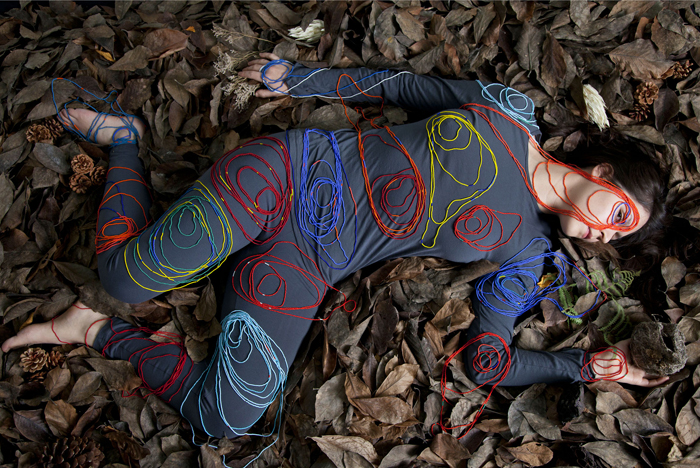The claws of a big brown and white animal hugging a tree trunk—that was the first image I saw from Meryl McMaster a few years ago. The figure was completely hidden behind the tree. Was it hiding from some predator? Or was it a predator itself, ready to fly up and attack us in the next moment? What species was it? Hard to decide. It was fearsome and playful at the same time. Perhaps it was an animal hiding in a human body or maybe a human in an animal skin—a very strange photograph. I soon forgot the artist’s name but not the image.
Wandering around and slightly bored on a Saturday afternoon, I found myself at Katzman-Kamen Gallery in Toronto. There I saw a large photograph depicting a young woman with skin painted white holding a strange metal wire form in front of her face. It was an unsettling portrait with elements that didn’t belong together. Then in 2012, NY Arts Magazine included a similar image in its list of young artists to be watched. Meryl McMaster was young, talented and seemed to have a unique imagery at her disposal.
In Toronto’s CONTACT 2013, she had a solo show, titled In-Between Worlds, which honored her mixed background. Both of her parents are from Saskatchewan; her father is Plains Cree and her mother is of British, Scottish, and Dutch heritage. “This always caused conflict for me and posed a challenge in presenting them as a synergistic strength, not as a struggle between opposites.” said McMaster.
Identity has been the central theme in her art from the beginning. The Second Self series (2010-11) reconsiders portraiture by incorporating drawing and sculpture into the photographic image to evoke a world that is not normally seen. McMaster was influenced by New York Times illustrator Saul Steinberg’s work Le Masque, and especially by his idea that everyone wears masks, either real or metaphorical. The head is the embodiment of our self-perception and is often misrepresented. McMaster wanted to show the real and the masked self of a person in one image. She asked friends to draw blind-contour portraits of themselves. Then, using wire, she created sculptures that were exact replicas of these drawings. She painted her models’ faces white, to make them “naked,” and suspended the blind-contour wire versions in front of them. In this way she created dualistic images, which appear confrontational and challenging while at the same time light-hearted and playful.
In In-Between Worlds McMaster focused her interest on historical and tribal identity in order to express her mixed heritage through different symbols. In Brumal Tattoo, she constructed a sculptural, armor-like garment of pinecones. The figure is beating a large drum. Historically, Europeans used “field music” to control troops on the battlefield as well as for entertainment. In Native Canadian culture, the beating of a drum represents the beating heart and the soul. The braided, many different patterned fabrics show the merging of her two ancestries. “Brumal” means wintery and “Tattoo” means either a signal sounded on a drum or a permanent mark on the skin. The sound and vibrations leave patterns depicted in red paint splattered on the landscape and on the body. For McMaster it is a tattoo of the past, present, and future.
Nature is a great influence on McMaster. From her teenage years on she has been exploring and working in Canada’s remote natural landscapes. As part of these trips everyone had to learn to survive by going through a “solo” experience in which they were left by themselves with only a little food and shelter supplies for 3 days. For McMaster it meant not only being bored because she was not allowed to bring anything with her (eg. a book or music) but she was also scared at times as her imagination ran wild listening to all the forest noises, especially at night. “Following the struggle of seclusion, I began to feel a sense of empowerment. It was these moments of being both in the group, as well as alone in such a harsh foreign environment that profoundly affected me and changed how I see the world.” said McMaster. Reflecting on this experience, she discovered many similarities to the vision quest in which Plains Cree youth go out alone into the wilderness, and, through a combination of isolation and fasting, try to find themselves and their life direction.
Some of the photographs in In-Between Worlds are a further embodiment of this transformation. She gave the images dream-like qualities as she remembered odd and unexplainable situations from her “solo” experience. In Terra Cognitum, the concentric circles depict a topographic map overlaid on the artist’s body and on the ground representing the colonization of the land and McMaster’s connection to it. The small colorful seed beads she used were part of traditional Cree clothing as well as currency during the colonial period. She intentionally left out sections of the map to reference her ongoing exploration of herself.
All the images are “staged” photographs. While photography is McMaster’s primary medium, she often incorporates other artistic media, including sculpture. This synergy creates a surreal, augmented imagery. In-Between Worlds was photographed in Ottawa in the middle of winter using natural light. McMaster is the model in all of these photographs. As she explained, “I inserted my own body into visual spaces that reflected both the inspiration I felt from my time alone in nature as well as the concept of being ‘betwixt.’”
McMaster’s stories might have their roots in both native and colonial tales but in the end she dreams up hybrid heroes. Then she gets into their skins, dances with the spirits, and creates her own myths.
By Emese Krunak-Hajagos
























